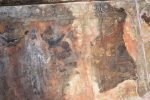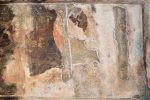Lepakshi, Virabhadraswamy Temple
Historical background
The small town of Lepakshi in the region known as Rayalaseema, Royal Realm, in south-western Andhra Pradesh, is famous for its temple dedicated to Virabhadra. The monument extends over a rocky outcrop known as Kurmsaila, or Tortoise Hill, a name deriving from its shape which recalls the shell of a tortoise. This uneven terrain had an impact on the layout of the temple, which incorporates several huge natural boulders and seven small shrines dedicated to various deities. No epigraphs are available recording the foundation date of the temple. Local legends attribute its origin to the mythical sage Agastya, and a small shrine dedicated to him is in the inner precincts of the complex. The temple dates back to before the 16th century, but was expanded to its present dimensions during the Vijayanagara period. Tradition credits the construction of the present monument to Virapanna, the governor of Penukonda, and his brother Viranna, representatives of the Vijayanagara emperor Achyutaraya (r. 1530-42). Grants dating from 1531 to 1538 inscribed on the enclosure walls and onto the adjacent bedrock suggest a concentrated period of building activity. It may be assumed that Virapanna and Viranna were responsible for bringing the seven shrines scattered on Kurmasaila into one coordinated architectural complex, and that the outstanding ceiling paintings, the only surviving murals of the Vijayanagara period, date from these years.
Read more
The main temple is entered from the north through a pair of gateways with uncompleted brick towers. The inner gateway leads directly into a grandly-scaled natyamandapa (‘dance hall’). This open structure has 70 majestic granite columns carved with nearly human-size deities, celestial musicians and dancers. They carry a ceiling almost 4 metres high above the floor. At its centre a corbelled dome with elaborate carvings reaches a height of c. 6.4 metres. Steps on the south side of the natyamandapa ascend to a narrow columned verandah that runs around three sides of the outer walls of the inner part of the temple. The ceilings of the natyamandapa and verandah just noticed are covered with fine paintings.
The inner part of the Virabhadra temple comprises a spacious, but poorly lit mahamandapa (‘great hall’), off which open a number of shrines. The central space of the hall is adorned with a single painted composition of Virabhadra (c. 7.6 x 4.2 m), the deity worshipped in the sanctuary at the far end of the hall. Other paintings, now damaged are seen on the ceilings over the side bays of the hall, on the walls and ceiling of the passageway running around three sides of the Virabhadra sanctuary, in the Shayanagara (bedroom of the deities), and in the subsidiary shrine known as the Raghunathalaya.
The subjects depicted are mostly devotional, drawn from the popular epics, the Periya Puranam and other texts. They include also depictions of Virapanna and Viranna, the temple donors, together with their retinues, thereby offering an invaluable visual record of courtly life during Vijayanagara times.

Date: First half of the 16th century
Description: Aspects of Shiva; Chandrashekharamurti; A large crescent moon rests on the front of the god’s crown. Two ascetics are shown on Chandrashekhara’s right, and one one on his left. Two celestials fly in the clouds above.
Two-armed Parvati (?) seated on a beautifully decorated lotus throne. On her right is a female attendant. The figure on her left, possibly Shiva, has disappeared except for fragments of a crown of dreadlocks.
Location: Andhra Pradesh Temple;Virabhadraswamy Temple;Lepakshi
Positioning: Colonnaded verandah, north bay

Date: First half of the 16th century
Description: Two-armed Parvati (?) seated on a beautifully decorated lotus throne. On her right is a female attendant. The figure on her left, possibly Shiva, has disappeared except for fragments of a jatamakuta (crown of dreadlocks).
Aspects of Shiva; Chandrashekharamurti (Having the moon as diadem). A large crescent moon rests on the front of the god’s crown. Two ascetics are shown on Chandrashekhara’s right, and one one on his left. Two celestials fly in the clouds above.
Two-armed Parvati (?) seated on a beautifully decorated lotus throne. The goddess carried a lotus in her right hand; the left hand is in varada mudra. She is dark-complexioned, elegantly attired. On her right is a female attendant. The figure on her left, possibly Shiva, has disappeared except for fragments of a crown of dreadlocks.
Location: Andhra Pradesh Temple;Virabhadraswamy Temple;Lepakshi
Positioning: Colonnaded verandah, north bay
« Previous 1 … 12 13 14